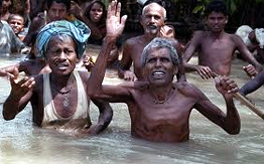World risk report 2012: environmental degradation and disasters

This new report shows how environmental degradation reduces the capacity of societies to deal with disaster risk in many countries around the world. It examines who is at risk from natural disasters, what contributes to this risk and what can be done about it.
World Risk Report 2012, which shows how environmental degradation reduces the capacity of societies to deal with disaster risk in many countries around the world. The World Risk Report examines who is at risk from natural disasters, what contributes to this risk and what can be done about it. The record for the decade 2002 to 2011 is alarming: 4,130 disasters, more than a million deaths and an economic loss of at least 1.195 trillion dollars. The centerpiece of the report, the WorldRiskIndex, developed by UNU-EHS in cooperation with the Alliance, determines the risk of becoming the victim of a disaster as a result of natural hazards for 173 countries throughout the world. This report illustrates the powerful role that nature can play in reducing risks to people and property from coastal hazards like storms, erosion and floods. Coral reefs, oyster reefs and mangroves offer flexible, cost-effective, and sustainable first lines of defense, as well as other benefits like healthy fisheries and tourism that sea walls and breakwaters will never provide.
See Also
Report: Worldrisk report 2011.
Opinion: Six sins that make drought...
Feature: Kolkata among world's most flood-prone coastal cities.
Report: Managing the Risks of Extreme Events and Disasters...
Report: Global assessment report on disaster risk reduction 2011.
Report: Cities and climate change.
Report: Environmental extremes disaster risk management.
Report: Making cities resilient report.
